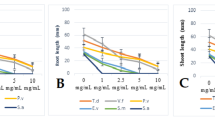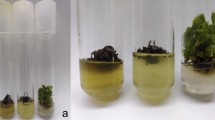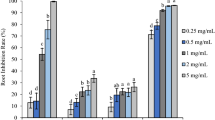Abstract
The effect of cedrelanolide, the most abundant limonoid isolated from Cedrela salvadorensis (Meliaceae), was assayed as a plant-growth inhibitory compound against monocotyledonous and dicotyledonous seeds. This compound inhibited germination, seed respiration, and seedling dry weights of some plant species (Lolium multiflorum, var. Hercules, Triticum vulgare, var. Salamanca, Physalis ixocarpa, and Trifolium alexandrinum). Our results indicate that cedrelanolide interferes with monocot preemergence properties, mainly energy metabolism of the seeds at the level of respiration. In addition, the compound inhibits photophosphorylation, H+ uptake, and noncyclic electron flow. This behavior might be responsible for its plant-growth inhibitory properties and its possible role as an allelopathic agent.
Similar content being viewed by others
REFERENCES
ACHNINE, L., MATA, R., IGLESIAS-PRIETO, R., and LOTINA-HENNSEN, B. 1998. Impairment of photosystem II donor side by the natural product odoratol. J. Agric. Food Chem. 46:5313-5317.
ACHNINE, L., MATA, R., and LOTINA-HENNSEN, B. 1999. Interference of the natural product 7-oxo-7-deacetoxygedunin with CF0 of H+-ATPase on spinach chloroplasts. Pestic. Biochem. Physiol. 63:139-149.
CALERA, M. R., SOTO, F., SANCHEZ, P., BYE, R., HERNáNDEZ, B., ANAYA, A. L., LOTINA-HENNSEN, B., and MATA, R. 1995. Biochemically active sesquiterpene lactones from Ratibida mexicana. Phytochemistry 40:419-425.
CéSPEDES, C. L., CALDERÓN, J. S., KING-DIAZ, B., and LOTINA-HENNSEN, B. 1998. Phytochemical and biochemical characterization of epimeric photogedunin derivatives. Their different sites of interaction on the redox electron transport carrier of Spinacea oleracea L. J. Agric. Food Chem. 46:2810-2816.
CéSPEDES, C. L., CALDERÓN, J. S., SALAZAR, J. R., KING-DIAZ, B., and LOTINA-HENNSEN, B. 1999a. Allelopathic activity of photogedunins from Cedrela ciliolata (Meliaceae). Bol. Soc. Chil. Quím. 44:173-183.
CéSPEDES, C. L., CALDERON, J. S., GÓMEZ-GARIBAY, F., SEGURA, R., KING-DIAZ, B., and LOTINAHENNSEN, B. 1999b. Phytogrowth properties of limonoids isolated from Cedrela ciliolata. J. Chem. Ecol. 25:2665-2676.
CéSPEDES, C. L., CALDERÓN, J. S., LINA, L., and ARANDA, E. 2000. Growth inhibitory effects on fall armyworm. Spodoptera frugiperda of some limonoids isolated from Cedrela spp. (Meliaceae). J. Agric. Food Chem. 48:1903-1908.
CHAMPAGNE, D. E., KOUL, O., ISMAN, M. B., SCUDDER, G. G. E., and TOWERS, G. H. N. 1992. Biological activity of limonoids from the rutales. Phytochemistry 31:377-394.
DILLEY, R. A. 1972. Ion transport (H+, K+, Mg2+ exchange phenomena). Methods Enzymol. 24:68-74.
EINHELLIG, F. A. 1986. Mechanisms and modes of action of allelochemicals, pp. 171-188, in R. A. Putnam and Ch-Sh. Tang (eds.). The Science of Allelopathy. John Wiley & Sons, New York.
EINHELLIG, F. A. 1995. Mechanism of action of allelochemicals in a allelopathy, pp. 96-116, in Inderjit, K. M. M. Dakshini, and F. A. Einhellig (eds.). Allelopathy Organisms, Processes, and Applications, ACS Series 582, American Chemical Society, Washington, D.C.
GOVINDACHARI, T. R., SURESH, G., BANUMATHY, B., MASILAMANI, S., GEETHA GOPALAKRISHNAN, and KUMARI, G. N. K. 1999. Antifungal activity of some B,D-seco limonoids from two meliaceous plants. J. Chem. Ecol. 25:923-933.
HATFIELD, J. L., and KARLEN, D. L. 1994. Sustainable Agriculture Systems. Lewis Publishers, Boca Raton, Florida.
ISMAN, M. B., MATSUURA, H., MACKINNON, S., DURST, T., TOWERS, G. H. N., and ARNASON, J. T. 1996. Phytochemistry of the Meliaceae: So many terpenoids, so few insecticides, pp. 155-178, in J. T. Romeo, J. A. Saunders, and P. Barbosa (eds.). Phytochemical Diversity and Redundancy in Ecological interactions. Plenum Press, New York.
JIMéNEZ, A., MATA, R., LOTINA-HENNSEN, B., ANAYA, A. L., and VELASCO, L. 1996. Phytogrowth-inhibitory compounds from Malmea depressa. J. Nat. Prod. 59:202-204.
JIMéNEZ, A., MATA, R., PEREDA-MIRANDA, R., CALDERON, J., ISMAN, M. B., NICOL, R., and ARNASON, J. T. 1997. Insecticidal limonoids from Swietenia humilis and Cedrela salvadorensis. J. Chem. Ecol. 23:1225-1234.
KRAUS, W. 1995. Biologically active ingredients, pp. 35-88, in H. Schmutterer (ed.). The Neem Tree Azadirachta indica, A. Juss and Other Meliaceous Plants. Sources of Unique Natural Products from Integrated Pest Management, Medicine, Industry and Other Purposes XXIII. VCH, Weinheim.
LI, H. H., NISHIMURA, H., HASEGAWA, K., and MIZUTANI, J. 1992. Allelopathy of Sasa cernua. J. Chem. Ecol. 18:1785.
LOTINA-HENNSEN, B., MATA, R., CALDERÓN, J. S., CéSPEDES, C. L., and JIMENEZ-ESTRADA, M. 1998. Secondary metabolites isolated from Mexican plants: Target and mechanism of action on photosynthesis, pp. 731-749, in S. G. Pandalai and A. Gayathri. (eds.). Recent Research Developments in Agricultural & Food Chemistry, Vol. 2. Research Signpost, Trivandrum, India.
LOWERY, D. T., EASTWELL, K. C., SMIRLE, M. J. 1997. Neem seed oil inhibits aphid transmission of potato virus Y to pepper. Ann. Appl. Biol. 130:217-225.
MACKINNON, S., DURST, T., ARNASON, J. T., ANGERHOFER, C., PEZZUTO, J., SáNCHEZ-VINDAS, P. E., POVEDA, L. J., and GBEASSOR, M. 1997. Antimarial activity of tropical Meliaceae extracts and gedunin derivatives. J. Nat. Prod. 60:336-341.
MATA, R. 1996. Bioactive compounds of medicinal and agrochemical interest from Mexican plants. Rev. Latinoam. Quím. 24:76-83.
MATSUDA, H., YOSHIKAWA, M., and KUBO, M. 1998. Antinociceptive and antiinflammatory activities of limonin isolated from the fruits of Evodia rutaecarpa var bodinieri. Planta Med. 64:339-342.
MILLS, J. D., MITCHELL, P., and SCHURMANN, P. 1980. Modulation of coupling ATPase activity in intact chloroplasts. FEBS Lett. 112:173-177.
MOHR, H., and SCHOPFER, P. 1995. Plant Physiology. Springer-Verlag, Berlin. 629 pp.
SAHA, S., OUITRAKUL, R., IZAWA, S., and GOOD, N. 1971. Electron transport and phosphorylation in chloroplasts in function of the electron acceptor. J. Biol. Chem. 246:3204-3209.
SCHMUTTERER, H. 1995. The Neem Tree Azadirachta indica, A. Juss and Other Meliaceous Plants: Sources of Unique Natural Products for Integrated Pest Management, Medicine, Industry and Other Purposes. VCH, Weinheim.
SEGURA, R., CALDERÓN, J., TOSCANO, R., GUTIéRREZ, A., and MATA, R. 1994. Cedrelanolide I, a new limonoid from Cedrela salvadorensis. Tetrahedron Lett. 35:3437-3440.
SEGURA-CORREA, R., MATA, R., ANAYA, A. L., HERNANDEZ-BAUTISTA, B., VILLENA, R., SORIANOGARCIA, M., BYE, R., and LINARES, E. 1993. New tetranortriterpenoids from Swietenia humilis. J. Nat. Prod. 56:1567-1574.
STRAIN, H. H., COPPE, B. T., and SVEC, W. A. 1971. Analytical procedures for the isolation, identification, estimation and investigation of the chlorophylls. Methods Enzymol. 23:452-466.
TADA, K., TAKIDO, M., and KITANAKA, S. 1999. Limonoids from fruit of Melia toosendan and their cytotoxic activity. Phytochemistry 51:787-791.
TAYLOR, D. A. H. 1979. A limonoid, Pseudrelone B, from Pseudocedrela kotschyii. Phytochemistry 18:1574-1576.
VAN GORKOM, H. J., and GAST, P. 1996. Measurement of photosynthetic oxygen evolution, pp. 391-405, in J. Amesz and A. J. Hoff (eds). Biophysical Techniques in Photosynthesis. Advances in Photosynthesis. Kluwer Academic, Dordrecht, The Netherlands.
VEITCH, N. C., WRIGHT, G. A., and STEVENSON, P. C. 1999. Four new tetranortriterpenoids from Cedrela odorata associated with leaf rejection by Exopthalmus jekelianus. J. Nat. Prod. 62:1260-1263.
WEIMIN, Z., WOLFENDER, J. L., HOSTETTMANN, K., RENSHENG, X., and GUOWEI, Q. 1998. Antifungal alkaloids and limonoids derivatives from Dictamnus dasycarpus. Phytochemistry 47:7-11.
ZHOU, J-B., TADERA, K., MINAMI, Y., YAGI, F., KURAWAKI, J., TAKEZAKI, K., and NAKATANI, M. 1998. New limonoids from Melia toosendan. Biosci. Biotechnol. Biochem. 62:496-500.
Author information
Authors and Affiliations
Rights and permissions
About this article
Cite this article
Céspedes, C.L., Calderón, J.S., Salazar, J.R. et al. Plant-Growth Inhibitory Activity of Cedrelanolide from Cedrela salvadorensis. J Chem Ecol 27, 137–149 (2001). https://doi.org/10.1023/A:1005628302652
Issue Date:
DOI: https://doi.org/10.1023/A:1005628302652




